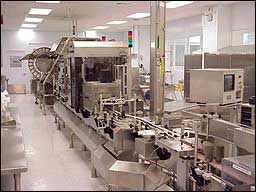A Complete Packaging Line
A packaging line is just like a chain and a very busy place, with many
machines doing many different things. The design and layout of equipment has
major impact on the efficiency of the packaging line. Well designed
equipment will lend itself to efficient production of a consistent standard,
whereas older equipment can often be inflexible and may have elements of
poor design such as areas where packaging components or product may be
trapped. These traps" can result in products being incorrectly packed,
e.g. A carton containing the wrong leaflet or product from a different
batch.
This represents a significant risk to the patient and is one of the major
reasons for product recall in the industry. The greater the number of stages
there are in a packaging line, the lower its efficiency will be. With modern
order patterns of short runs it may for example be better to have two slow
speed fillers feeding a single cartonner rather than a single high-speed
filler.
Appropriate validation of the packaging lines will challenge the
robustness of the packaging operation establishing the conditions under
which efficiency maximized.
Design considerations for a line layout should include the ability to
manage quick change-over, perform line clearance between batches of product
and clean the line in an easy and controlled manner. The majority of
problems on packaging lines are related in some way to poor line clearance;
it is therefore important to design these problems out. A typical packing
line will consist of several feeders for packaging components and product.
Devices will normally be located in critical positions on the line to detect
presence or otherwise of the materials.
For example, a device installed on the carton feeder will ensure that a
carton is supplied for each product or tray of product and a barcode reader
will verify that it is the correct one. A checkweigher will make certain
that underfilled or overfilled bottles are identified and ensures via the
reject device that they are excluded from the batch. The layout of the
equipment should guarantee that easy access is provided for operators and
the engineers to access this equipment when adjustments and or maintenance
are required.
Any validation exercise must start with a detailed Validation Master Plan
(VMP). A VMP will normally include the company validation policy, explaining
how the company will manage the validation exercise and details of the
organizational structure relevant to the validation activities. The VMP
should also include a summary of the facilities, systems, equipment and
processes which are to be validated and indicate the format which is to be
used for documentation. All critical equipment and systems must be
identified and listed in the VMP, including a list of critical devices
and/or details of the operating system and the software used.

A high level
plan of activities should be developed and broken down into stages within a
schedule. Any validation activity is only as good as the change control
process used; the VMP should include details of how any changes will be
managed. Finally, a list of references to any other relevant documentation
should be included.


